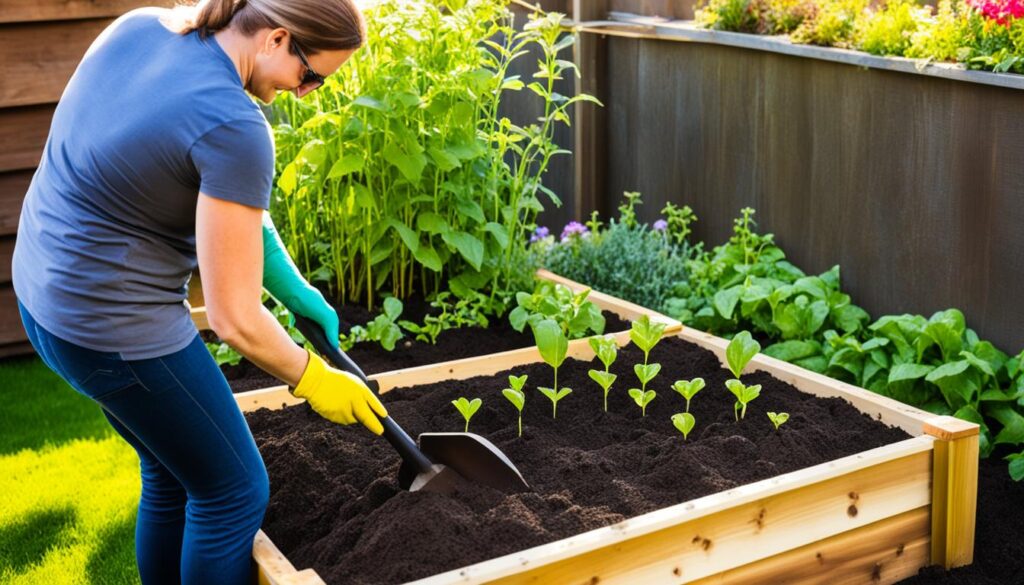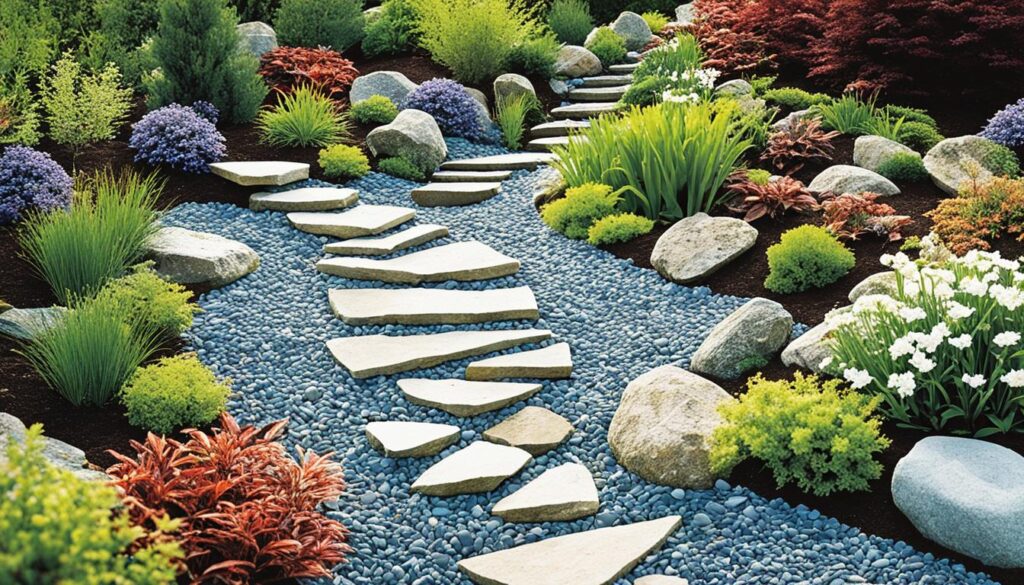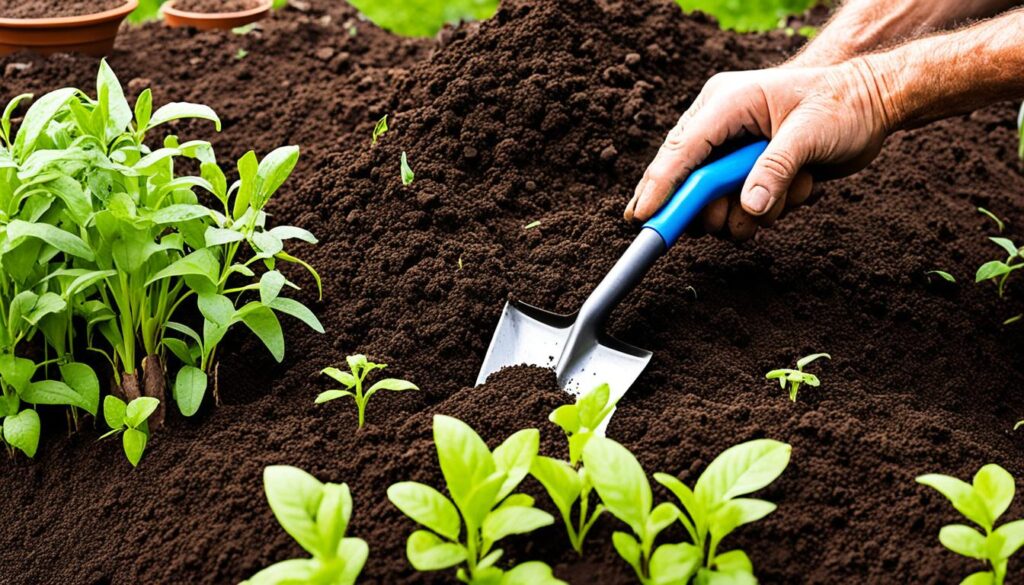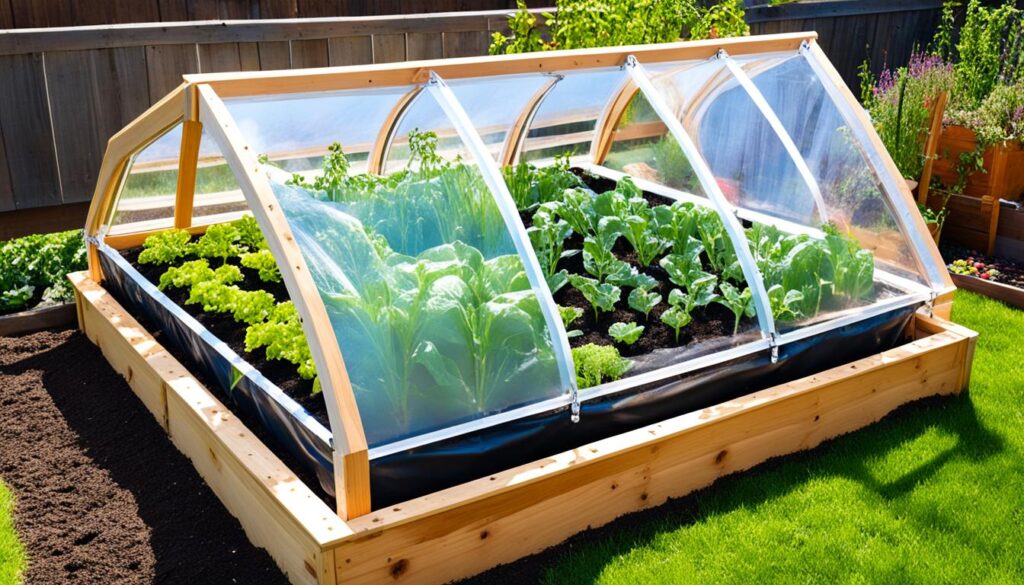Are you wondering how much soil you need for your raised bed garden? Determining the right amount of soil is essential to ensure your plants have enough space to grow and thrive. Fortunately, there’s a simple solution: a soil calculator. By using a soil calculator, you can easily determine the exact quantity of soil required for your raised bed. Let’s explore how to calculate the soil volume and create the perfect environment for your plants.
Key Takeaways:
- Using a soil calculator helps you determine the precise amount of soil needed for your raised bed.
- The recommended soil blend for raised beds includes a combination of topsoil, compost, and soilless potting mix.
- Accurately measuring the dimensions of your raised bed ensures you have enough soil to fill it properly.
- Buying soil in bulk can be a cost-effective option for filling multiple raised beds.
- Reusing old potting soil in your raised beds is possible with proper nutrient replenishment.
Now that you know the importance of determining the right amount of soil for your raised bed, let’s dive deeper into how to use a soil calculator and the recommended soil blend for optimal plant growth.
Using a Soil Calculator for Raised Beds
A soil calculator is a useful tool for determining the amount of soil required for your raised bed. By inputting the measurements of your bed, such as length, width, and depth, the calculator will provide you with the volume of soil needed in cubic yards or cubic feet. This helps ensure that you purchase the correct amount of soil for your project and avoid any wastage or shortage. It is recommended to calculate the soil volume for each individual raised bed to ensure accuracy.
Calculating soil volume manually can be time-consuming and prone to errors. With a raised bed soil calculator, the process becomes quick and effortless. Simply enter the dimensions of your bed and let the calculator do the work for you. You will receive accurate measurements in cubic yards or cubic feet, taking the guesswork out of purchasing soil.
Using a soil calculator also allows you to plan and budget more effectively. By knowing the exact volume of soil required, you can calculate the cost and make informed purchasing decisions. This helps you avoid overspending or running out of soil during your gardening project.
When using a soil calculator, it’s important to remember that each raised bed is unique. If you have multiple beds, calculate the soil volume individually for each one. This ensures that you account for any variations in size or shape, resulting in precise measurements and optimal soil quantities.
Soil Recommendations for Raised Beds
When filling your raised bed, it is important to use high-quality soil that is rich in nutrients and organic matter. This will provide an ideal environment for your plants to thrive.
A recommended soil mix for raised garden beds is a combination of 60% topsoil, 30% compost, and 10% soilless potting mix. This blend ensures proper drainage, water retention, and nutrient availability for your plants.
It is also important to remove any grass or perennial weeds from the area before placing your raised bed to prevent competition with your plants.
| Soil Component | Percentage |
|---|---|
| Topsoil | 60% |
| Compost | 30% |
| Soilless Potting Mix | 10% |

By using this soil mix, you create a balanced growing medium that provides the necessary nutrients for your plants’ growth, while also ensuring proper drainage and moisture retention.
Remember, the quality of your soil greatly influences the success of your raised bed garden. So, invest in good soil to give your plants the best chance to flourish!
Calculating Soil Volume for a Raised Bed
To ensure you have enough soil to fill your raised bed properly, it’s essential to calculate the soil volume needed. You can use a simple formula: length (in feet) x width (in feet) x depth (in feet). Let me illustrate this with an example.
For instance, consider a raised bed measuring 3 feet by 6 feet with 10-inch sides. To calculate the soil volume, we convert the depth to feet by dividing 10 inches by 12 (since there are 12 inches in a foot). Therefore, the depth is 0.83 feet.
Using the formula, we multiply 3 (length) by 6 (width) by 0.83 (depth). This gives us a soil volume of approximately 15 cubic feet.
| Soil Type | Volume (cubic feet) |
|---|---|
| Topsoil | 9 |
| Compost | 4.5 |
| Soilless Potting Mix | 1.5 |
| Organic Fertilizer (cups) | 1.5 |
Based on the example, you would require 9 cubic feet of topsoil, 4.5 cubic feet of compost, 1.5 cubic feet of soilless potting mix, and 1.5 cups of organic fertilizer to fill your raised bed. These quantities ensure a balanced blend of nutrients and provide an optimal growing environment for your plants.
Remember, it’s crucial to accurately measure the dimensions of your raised bed to calculate the soil volume precisely. This way, you can avoid any shortage or excess soil and create the ideal conditions for your plants to thrive.

Buying Soil in Bulk for Raised Beds
If you have multiple raised beds to fill, buying soil in bulk can be a cost-effective option. Bulk soil is typically sold by the cubic foot or cubic yard. When purchasing soil in bulk, it is important to consider the proportions of topsoil, compost, and soilless potting mix to ensure the ideal soil blend for your raised bed gardening needs.
By using the soil calculator to determine the total amount of soil required for all your beds combined, you can make an informed decision when buying in bulk. This helps you avoid any wastage or shortage of soil. It also ensures that you have enough soil to properly fill each of your raised beds.
When determining the proportions of topsoil, compost, and soilless potting mix, you can use the recommended blend of 60% topsoil, 30% compost, and 10% soilless potting mix as a guideline. These proportions provide the optimal balance of nutrients, drainage, and water retention for your raised bed plants.
Buying soil in bulk not only saves you money but also ensures that you have enough soil to create a healthy growing environment for your raised bed plants. Remember to consider the proportions of topsoil, compost, and soilless potting mix and use the soil calculator to determine the total soil needed for your beds. This way, you can buy soil in bulk and achieve successful gardening in your raised beds.

Reusing Old Potting Soil in Raised Beds
You can reuse old potting soil in your raised beds, but it’s important to give it a boost of nutrients to ensure good results. One way to achieve this is by blending new soil into the old soil, revitalizing its fertility and structure. If the level of soil has dropped over time, you can also top it off with fresh potting mix to bring it back to the desired level.
When reusing old potting soil, it’s recommended to add organic fertilizer and a booster mix to provide essential nutrients for your plants. This replenishes the depleted soil, promoting healthy plant growth and creating an ideal growing environment in your raised beds.
Blending New Soil into Old Soil
To blend new soil into the old potting soil:
- Remove any debris or roots from the old potting soil.
- In a separate container, combine equal parts of new potting mix and the old soil.
- Thoroughly mix the two together, ensuring that the new soil is evenly distributed throughout.
This process helps rejuvenate the old soil by introducing fresh nutrients and improving its texture, creating a fertile and well-draining medium for your plants.
Topping Off the Soil Level in Raised Beds
If the level of soil in your raised beds has decreased, you can top it off with fresh potting mix. This helps restore the volume of soil needed for optimal plant growth. Here’s how:
- Determine the desired soil level in your raised bed.
- Add fresh potting mix to the raised bed, filling it up to the desired level.
- Gently compact the soil to ensure proper settling and stability.
Topping off the soil level is especially beneficial if your existing potting soil is still in good condition but requires a small replenishment. It saves you from completely replacing the old soil, while still providing the necessary volume for healthy plant development.
Remember to choose a potting mix that is compatible with the types of plants you want to grow in your raised beds. Different plants have varying nutrient requirements, and selecting the right potting mix will ensure optimal growth and productivity.
Tips for Growing Plants in Raised Beds
When growing plants in raised beds, there are a few tips to keep in mind. Firstly, it is important to prepare the soil by removing any grass or weeds and loosening the native soil before placing the raised bed. This improves drainage and moisture retention in the beds.
Secondly, regular feeding of plants with organic fertilizer is essential for healthy growth. Organic fertilizers provide a slow release of nutrients, promoting steady and continuous plant development.
Finally, consider the specific needs of the plants you are growing and provide them with the appropriate care. This includes watering them adequately, providing sufficient sunlight, and providing support, such as stakes or trellises, if needed.
Growing plants in raised beds offers several benefits. The controlled environment allows for better soil quality and drainage, reduces weed competition, and minimizes pest and disease issues. It also makes gardening more accessible by reducing bending and kneeling.
Tips for Growing Plants in Raised Beds:
- Prepare the soil by removing grass and weeds
- Loosen the native soil before placing the raised bed
- Feed plants regularly with organic fertilizer
- Water plants adequately
- Provide sufficient sunlight
- Consider the specific needs of the plants
- Provide support, such as stakes or trellises
By following these tips and providing the proper care, you can ensure healthy plant growth and maximize the productivity of your raised bed garden.
| Pros of Growing Plants in Raised Beds: | Cons of Growing Plants in Raised Beds: |
|---|---|
| Improved soil quality | Requires initial setup and construction |
| Better drainage and moisture retention | Potentially higher initial cost |
| Reduced weed competition | May require more frequent watering |
| Minimized pest and disease issues | May require regular soil amendments |
| Accessible gardening for those with physical limitations | Requires periodic soil replenishment |
Remember, raised bed gardening provides an excellent opportunity to grow a wide variety of plants in a controlled environment. With proper preparation and care, you can enjoy a bountiful and thriving garden.
Benefits of Using a Topsoil Calculator for Raised Beds
Using a topsoil calculator for raised beds offers several benefits. Firstly, it helps you determine the precise amount of topsoil needed for your project, eliminating the guesswork and ensuring that you order the correct quantity. This reduces the risk of wasted soil or insufficient coverage.
Secondly, a topsoil calculator allows you to calculate the cost of the soil required, helping you budget for your raised bed project. By knowing the exact amount of topsoil needed, you can accurately estimate the expenses and plan accordingly. This saves you from any unexpected financial surprises.
Moreover, using a topsoil calculator for raised beds saves you time and effort. Instead of manually calculating the volume of soil needed, the calculator provides quick and accurate results with just a few simple inputs. This allows you to focus on other aspects of your gardening project, making the whole process more efficient and convenient.
“A topsoil calculator is an invaluable tool for anyone planning to create raised beds. It takes the guesswork out of determining the right amount of soil and helps in budgeting for the project. I highly recommend using it!” – Jane Foster, Experienced Gardener
Additionally, a topsoil calculator enables you to fine-tune your raised bed preparations. By having a precise measurement of the required topsoil volume, you can ensure that your bed has adequate soil depth for optimal plant growth. This helps create a healthy and supportive environment for your plants, leading to better yields and overall success in your gardening endeavors.
In conclusion, using a topsoil calculator for raised beds offers numerous benefits. It eliminates the guesswork, helps in budgeting, saves time and effort, and allows you to optimize your bed preparations. With these advantages, you can confidently create thriving raised beds and cultivate a flourishing garden.
How to Use the Topsoil Calculator for Raised Beds
To determine the volume of topsoil required for your raised beds, it’s crucial to use a topsoil calculator. Follow these simple steps to use the calculator effectively:
- Measure the dimensions of your bed: Start by measuring the length, width, and desired soil depth of your raised bed. Make sure to use the same units of measurement throughout the process.
- Enter the measurements into the calculator: Once you have the dimensions, enter them into the topsoil calculator. Input the values accurately to ensure precise calculations.
- Obtain the required topsoil volume: After entering the measurements, the calculator will provide you with the volume of topsoil needed for your raised bed. The result will be displayed in either cubic metres or cubic feet, depending on your preference.
By using the topsoil calculator, you can make informed decisions when purchasing topsoil for your raised beds. This ensures that you order the correct quantity of topsoil, avoiding wastage or running out of soil.
Tip: Double-checking the measurements is essential to ensure accurate results. Small errors in measuring the dimensions can lead to significant differences in the required topsoil volume.
Once you have determined the quantity of topsoil needed, you can proceed with purchasing the appropriate amount. Remember to consider the size and number of your raised beds when making your purchase. Using the topsoil calculator simplifies the process and helps you achieve optimal soil volume for successful gardening.
Example Calculation:
Let’s say you have a raised bed measuring 4 feet (length) by 2 feet (width) by 1.5 feet (depth). To calculate the topsoil volume needed:
4 feet x 2 feet x 1.5 feet = 12 cubic feet
Based on this calculation, you would require 12 cubic feet of topsoil to fill your raised bed.
Additional Considerations:
It’s essential to note that the topsoil calculator provides the volume of topsoil required. If you plan to incorporate other soil amendments, such as compost or soilless potting mix, remember to adjust the quantities accordingly. Maintaining the recommended soil blend, as mentioned in Section 3, will contribute to the overall health and productivity of your raised bed garden.
Now that you know how to use the topsoil calculator for raised beds, you can confidently plan and prepare your garden with the right amount of topsoil. Happy gardening!
Conclusion
When it comes to raised bed gardening, achieving the optimal soil volume is essential for successful plant growth. By using a soil calculator and following the recommended soil blend, you can create an ideal environment for your plants to thrive. Calculating the volume of soil required helps you avoid any wastage or shortage, ensuring that you purchase the right amount for your raised beds.
With the proper soil volume and a well-prepared bed, you can enjoy a bountiful garden and healthy plant growth. The recommended soil blend of 60% topsoil, 30% compost, and 10% soilless potting mix provides the necessary nutrients, drainage, and water retention for your plants. Remember to remove any grass or weeds before placing your raised bed to prevent competition with your plants.
Soil calculators offer convenience and accuracy in determining the exact soil volume needed for your raised beds. By inputting the dimensions of your beds, you can easily calculate the required amount of soil in cubic yards or cubic feet. This allows you to make informed decisions when purchasing soil, saving you time, money, and ensuring a successful gardening experience. Get started with raised bed gardening and create the optimal growing environment for your plants today!








